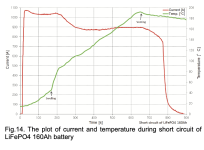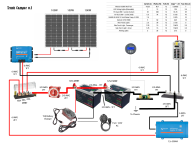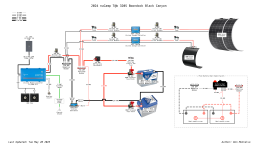I have a 120A Blue Sea class-t fuse that I was considering using after the two terminal MRBF fuses before the switch, which is ABYC code. In my case I'm not sure it's needed, but all for extra insurance. Not sure though to your point if needed with this smaller bank size. If I eventually add more power, I would consider it then.
There's nothing wrong with overkill but just know that fuse type selection is subject to some engineering discretion.
The underlying suggestion for using a class T fuse is based on the very low internal resistance of lithium chemistry which leads to a characteristic that they can source a great deal of current under short circuit conditions.
But it is not infinite or absolutely instantaneous, so don't get off into the weeds throwing big dollar industrial fuses at a problem if it's not justified.
The question is then of course what is justified and how do you know?
To find the theoretical short circuit current you start by finding by specification or test the internal resistance of your cell. I'll take the ones I used as an example, LEV60F prismatic. The specification for them is 0.75 mΩ. These cells prefer a little lower voltages than other LiFePO4 due to their originally intended applications. So they are considered fully charged at 3.5 V.
That means, in theory, these cells under short circuit will produce 3.5 V / 0.75 mΩ = 4,667 A if you short them the moment they come off the charger.
So we can already see that a 20,000 A class T isn't strictly needed even if I assume all worse case everywhere else in the circuit. MRBF is safe here and even that might not be needed.
You have cables, you have terminals, crimped connectors. Just the jumpers that connect four cells into a 12V battery increase the resistance. An 8" length of 6 AWG is about 0.25 mΩ so 3 of them plus the 4 cells is 3.75 mΩ, thus in my example the most current that can ever flow is 14 / 0.00375 = 3,733 amps and that's before I even assume normal construction imperfections. Add in the little bit at each lug/stud, the necking at the crimps. It's easy to see that maybe 5 to 10 mΩ is the real internal assembled battery resistance so can't be more than ~2,500 amps under ideal worst case.
Further, most research indicates that LiFePO4 is capable of about 20C to 30C under worst case short circuit. Which would imply my 74 A-hr cells will short circuit around 1,480 A to 2,220 A in the drop a spanner on the terminals test so you find the absolute sourcing limits of the plates and electrolyte. Even this is probably optimistic.

That plot taken from "Temperature, Overcharge and Short-Circuit Studies of Batteries used in Electric Vehicles" by Lebkowski. He found more like 9C to 10C. This is a data point, no telling if test rig configuration was current limiting, so this could be low. But still points to there being a limit.
Going to the next step, if your battery has an internal BMS you're looking at what fuse to use on the
outside of a finished battery. The BMS will try to limit current. Mine at level 3, the short circuit parameters, is set to open at 440 A at 400 μs. Now whether it
actually can limit a true short circuit is debatable but there's no question it will try. Even if it's not able to actually limit or break the circuit the effective resistance (with now burnt up FETs for example) has gone up and time of the fault has slowed down, which factors in to how fast your fuses have to react and the current they will have to break.
All I'm suggesting is we can get ourselves worked up over a problem that may not really exist. Some interwebz posts are talking lithium as it relates to a many hundred A-hr/48 V household installations feeding grid-tie inverters and dealing with raw cells in a DIY situation with parallel bus bars or 4/0 cables. In that case you do have to be very careful. Same with a 24V bank or if you have 200 or 300 A-hr, start to take more care. There's no minimal here, maximum there that's hard fast. Not a singular definition of "large bank" that dictates when one solution or another is required. Utility storage is definitely large. Your cell phone power bank is definitely not. Everything in-between is a matter of degrees.
So looking at your batteries, which aren't truly cell-level internal fuses so IMO are a grey area whether battery or wiring fuse.
The impedance spec is given at <30 mΩ tested. So let's just say that's what it is. That's suggesting short circuit 12.8 V / 0.030 Ω = 426 amps. That isn't the real cell internal resistance, but the resistive and reactive (capacitance and inductance) combination of the cells, wiring and BMS. So the specs aren't helpful there.
It elsewhere says short circuit protection is 600 A at 500 μs. That's the BMS cutting off.
So you can't really know from spec just what you need for interrupt unfortunately. It's unlikely there's a class T fuse inside. I wouldn't be surprised if there's no fuse inside, just the BMS. Maybe a fusible link or self reset breaker.
Thus the really unanswerable question is what to do. It's unlikely you really
need a class T or probably even MRBF to be safe. A fast blow ANL (minimally 2.7kA) or even a MEGA or MEGA 60V (the 60V version are 5kA interrupt) probably function acceptably. I just don't want everyone thinking you need to start tearing everything up and use the largest, most expensive fuses on every 12 V/100 A-hr house battery.
You're not being unsafe since you probably will realistically see less than 2kA to 3kA range of short circuit and that's only assuming things went badly sideways and your BMS doesn't work. Which you do have to at least consider as a failure mode. It's evolving understanding coupled with new and shiny tidbits of information that might be out of context.
And by the same token just because you hang 10kA interrupting fuses on a battery you're not absolutely safe either. An internal short or over charge might still cause your battery to overheat or any number of things could happen. So just having class T or MRBF doesn't excuse you from good practices on an enclosure, watching parameters, securing and sizing wiring and having an egress and fire extinguishing plan. When you decide to use lithium you can't be totally hands off.





